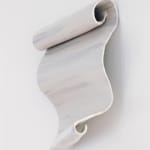






Yoon Young Hur
The Fold, #21, 2021
Grogged sculpture in clay with matte white glaze (hand-poured)
36.8 x 44.6 x 16.5 cm
Copyright the Artist
Further images
Inspired by the full breadth of Korean ceramic history, from ancient earthenware to the white porcelain of the Joseon dynasty, Hur’s pieces, fired by hand in Seoul, both preserve and...
Inspired by the full breadth of Korean ceramic history, from ancient earthenware to the white porcelain of the Joseon dynasty, Hur’s pieces, fired by hand in Seoul, both preserve and reinterpret this cultural heritage. After art and architecture school, she returned home to reconnect with her family and culture, and South Korea is where she honed many of her formal technical skills. “There’s this embrace of imperfection in Korean art, which differs greatly from Chinese art,” Hur said. “A moon jar’s seam, as well as the depressions and collapses that can happen within the kiln, are things to be celebrated, not discarded.” Some of her earliest work revolved around this archetype that is said to be representative of a Korean aesthetic at large. A spherical vessel with a narrow opening at the top, this type of jar is traditionally created by throwing two semicircular bowls, inverting one, and assembling them together before firing. While it is possible to throw the entire jar with no seam, she finds an imperfect connection to be a tangible interaction with a long lineage of ceramicists. “It represents a raw and direct record of the fleeting moment,” she says.
Hur’s most recent series, The Fold, takes many queues from her architectural training. Using a coarsely grained clay allows her to form with freedom and without using a wheel. Slabs are rolled flat, folded, and eventually arranged like walls or corridors, evoking linearity not often found in traditional ceramic practice. The concept of the fold is both the inspiration and the making process for this work. Besides the geological reference to the way tectonic plates are layered and formed through time and force, Hur is inspired by Deleuze’s The Fold-Leibniz and the Baroque (1988), in which he writes, ‘Perpetual displacement of contour, originates in the projection of something spiritual into matter.’ He also contends that there are ‘folds in the soul, where inflection becomes inclusion’. Hur associates undulating surfaces with the unpredictability and vulnerability in our lives, which can be embraced while at the same time being allowed to unfold, grow and open into multiple folds, or possibilities.
Hur’s most recent series, The Fold, takes many queues from her architectural training. Using a coarsely grained clay allows her to form with freedom and without using a wheel. Slabs are rolled flat, folded, and eventually arranged like walls or corridors, evoking linearity not often found in traditional ceramic practice. The concept of the fold is both the inspiration and the making process for this work. Besides the geological reference to the way tectonic plates are layered and formed through time and force, Hur is inspired by Deleuze’s The Fold-Leibniz and the Baroque (1988), in which he writes, ‘Perpetual displacement of contour, originates in the projection of something spiritual into matter.’ He also contends that there are ‘folds in the soul, where inflection becomes inclusion’. Hur associates undulating surfaces with the unpredictability and vulnerability in our lives, which can be embraced while at the same time being allowed to unfold, grow and open into multiple folds, or possibilities.













